 [As I indicated in the first post in this series, between September 6 and October 4 I spent my weekdays at the Institute of Art and Design at New England College, in Manchester, NH, on a Teti Photography Fellowship. You’ll find details of this program in that initial post; click here for part 2. In this installment I describe the last day of my residency, and discuss in detail the book with which I engaged to close my stay.
[As I indicated in the first post in this series, between September 6 and October 4 I spent my weekdays at the Institute of Art and Design at New England College, in Manchester, NH, on a Teti Photography Fellowship. You’ll find details of this program in that initial post; click here for part 2. In this installment I describe the last day of my residency, and discuss in detail the book with which I engaged to close my stay.
Click here for Part 2 of this series, and here for Part 4. — A.D.C.]
•
I finished my Teti Fellowship residency at the IAD@NEC early in the afternoon of October 4. My last day there — only a half-day, as the library closes at 1 on Fridays due to staff cutbacks — I spent thus:
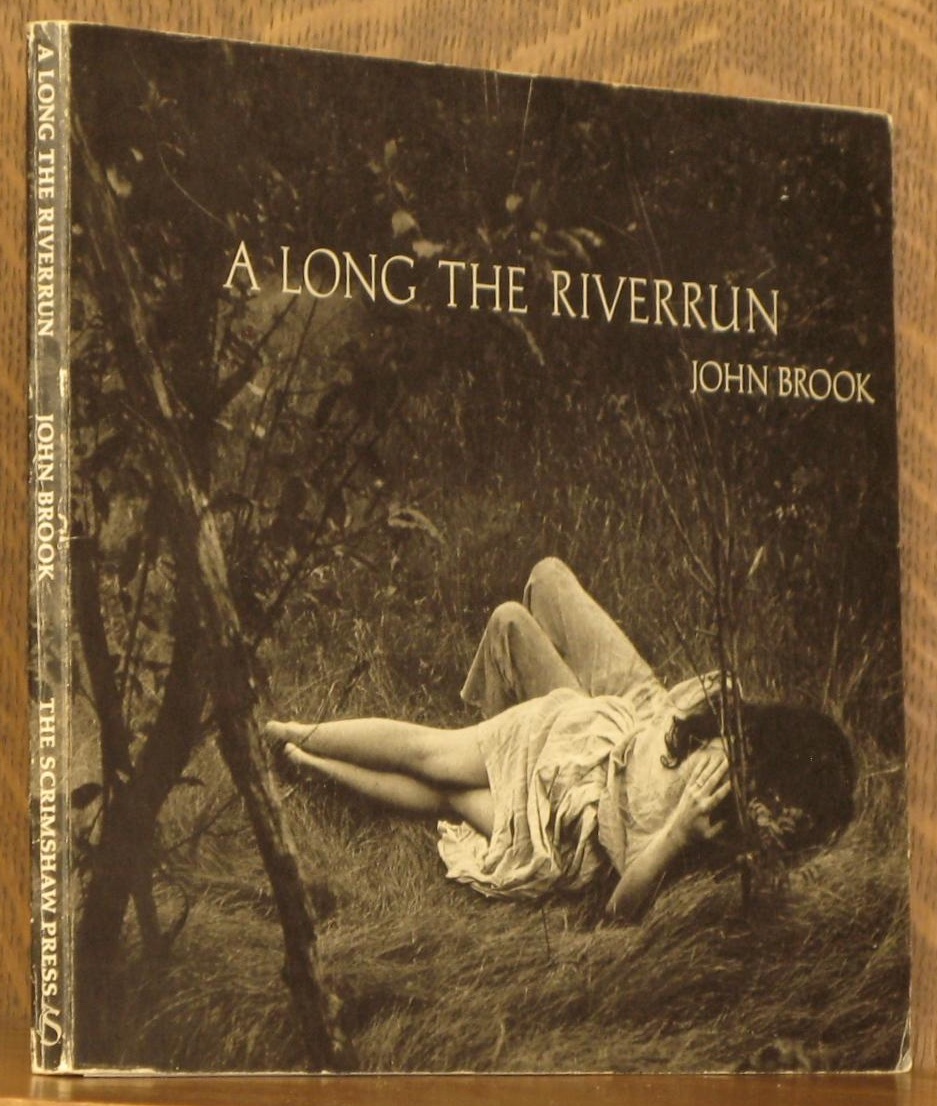
John Brook, Along the Riverrun (1970), cover
• Meeting for the first time and talking with Thomas Adams, a collector and former gallerist who has also made a substantial donation of prints to the collection. We discussed the work of the late John Brook, whose estate Adams manages and whose Scrimshaw Press monograph, Along the Riverrun, I reviewed for the Village Voice in December 1970.
• Having my portrait made by Yoav Horesh, nominal head of the photo department, who entertained me by describing an intriguing exhibition project he initiated upon discovering in the Teti Collection a print of Edward Weston’s “Pepper No. 32” (a variant on the more famous version of this image). I invited him to write a Guest Post about that project for this blog.
• Perusing yet again the most peculiar book I found in the collection: The Waters of Our Time (New York: powerHouse Books, 2014), by photographer Thomas Roma and his son Giancarlo T. Roma, a writer and musician. A diminutive quality paperback, a mere 5×7, it first drew my attention on a lower shelf in the Special Collections room because its black & white spine resembles that of the original edition of the classic collaboration between Roy DeCarava and Langston Hughes, The Sweet Flypaper of Life, first published in 1955 and recently reissued in a superb facsimile edition. That book has a special place in my heart, and I thought this was in fact a first edition thereof.
•
Until I found it there, I had no idea this would-be counterpart to Sweet Flypaper existed. Pulling it out, I discovered that its entire design (layout, typefaces) and even its production values (matte-finish, heavy, slightly off-white paper stock for the interior, with a heavier, matte-finish pebbled stock for the cover) replicate as exactly as possible the format and look and haptic feel of its predecessor. (Indeed, when the book first appeared Roma told interviewer Matthew Leifheit that “This book is an exact replica in size, number of pages, and number of pictures. Even the paper we used on the cover is the exact same stock. It’s an ancient stock that the printing press found for me in Italy.” Click here for a video run-through of the book.)
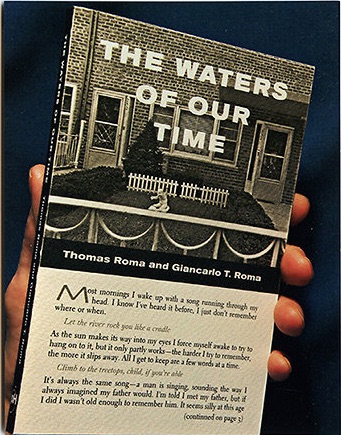
Thomas Roma and Giancarlo Roma, The Waters of Our Time (2014), cover
The authors acknowledge this, though somewhat less forthrightly, on the inside front cover, writing only that “We owe a debt of gratitude to Roy DeCarava and Langston Hughes for their book The Sweet Flypaper of Life, which inspired this one.” Be that as it may, I found the mimicry unnerving as I went through the book, comparing it with the library’s copy of the new edition.
Roma’s pictures, mostly small-camera b&w glimpses of daytime Brooklyn with some scenes of domestic life, fall (as Roma’s work in general does) into the classic street-photography mode that Garry Winogrand and Lee Friedlander built on the foundation established by Robert Frank. His son’s text, like Hughes’s, presents the ruminations of an elderly woman. Unlike its predecessor, this first-person fiction has its narrator not recollecting the particulars of her life or the people in it (with one exception) but instead meditating on the subjects of time and memory.
So whereas Hughes used DeCarava’s images to construct a narrative that reads like a transcript of a grandmother’s personal tour through the family album, contextualizing the images, the Roma team’s effort has the opposite effect. Except for the implication that these are images of places and people familiar to the narrator, as if all made in her own neighborhood, the photos have no direct relationship to the text, and vice versa. Moreover, Hughes was in his early fifties when he invented his narrator, whereas Roma fils had just entered his early twenties when he and his father published this book. The three decades’ difference in age and experience between the two writers accounts for the fact that Hughes’s Sister Mary Bradley comes to life, while Roma’s nameless narrator never does.
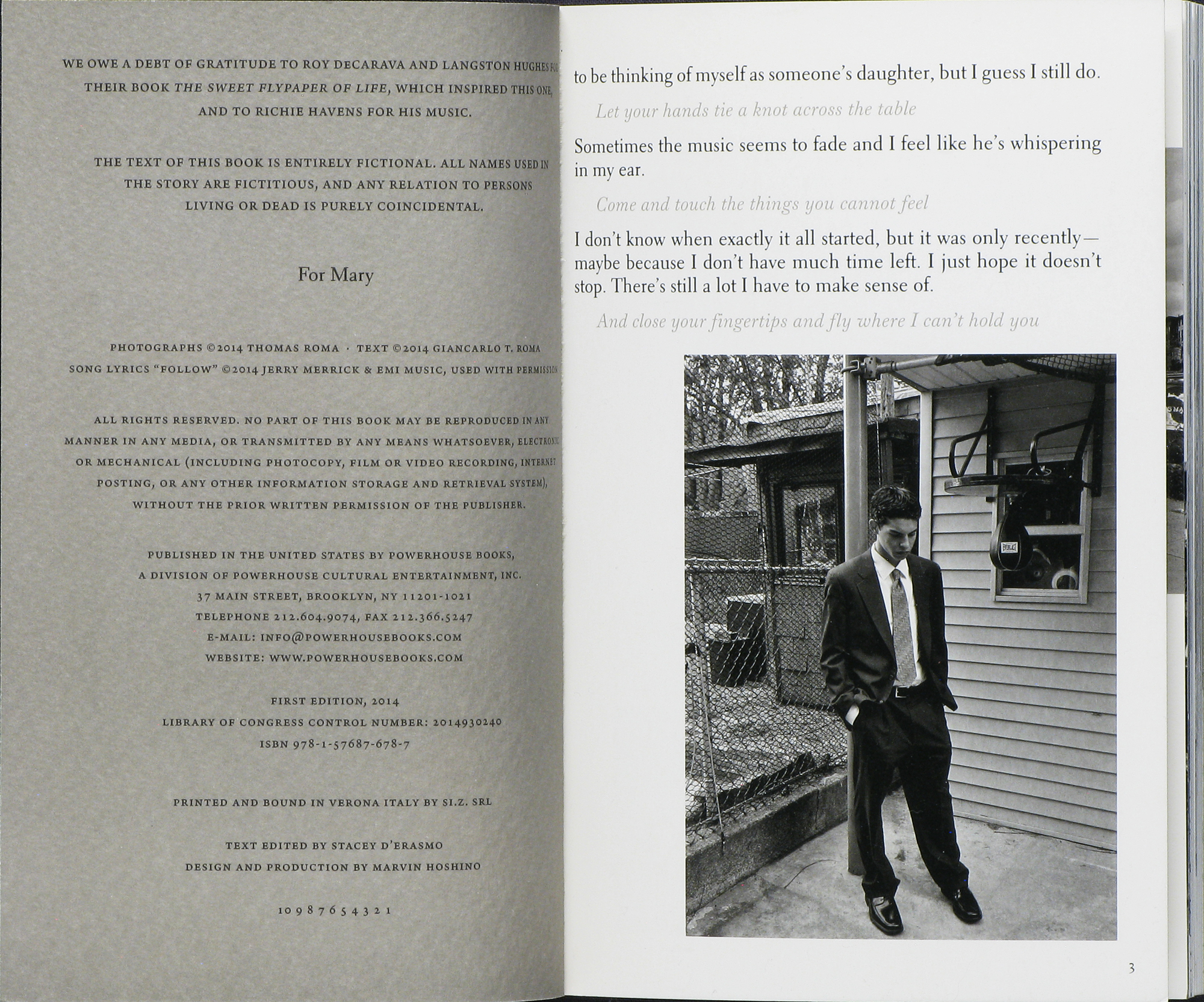
Thomas Roma and Giancarlo Roma, Waters of Our Time (2014), inside frontcover
•
I find particularly disconcerting the odd fact that the only name Roma fils gives to anyone from his character’s account of her past is “Roy,” her ostensible first love, who, she tells us, left Brooklyn (and her) many years ago, while she decided to stay. One cannot avoid making the obvious connection to DeCarava, though this does not fit with the biographical facts of his life; DeCarava was born and lived first in Harlem, then in the flower district of midtown Manhattan, and only much later in his life moved to the Bedford-Stuyvesant section of Brooklyn. So his presence as an unseen but important personage in the narrator’s life haunts the tale from its fourth page — where “Roy” first appears — to the end. (His name comes up intermittently throughout.)
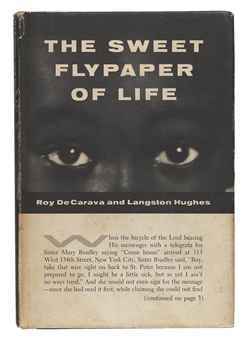 Given the countless male names from which Roma could have chosen, we have to take this as an effect intended by the author. You don’t casually name a significant character in your account after the person on whose work you have modeled your own. I consider that a strategic mistake, because it lurks in the mind, distracting from the teller’s explanations of why she opted to live her entire life in Brooklyn. The unnecessary yet deliberate use of DeCarava’s first name in the narrative drags him — a known, identifiable real-life figure — into the fictional monologue in a way that raises questions Roma makes no attempt to answer.
Given the countless male names from which Roma could have chosen, we have to take this as an effect intended by the author. You don’t casually name a significant character in your account after the person on whose work you have modeled your own. I consider that a strategic mistake, because it lurks in the mind, distracting from the teller’s explanations of why she opted to live her entire life in Brooklyn. The unnecessary yet deliberate use of DeCarava’s first name in the narrative drags him — a known, identifiable real-life figure — into the fictional monologue in a way that raises questions Roma makes no attempt to answer.
Moreover, it introduces a peculiarly problematic and unnecessary issue of race to the work as a red herring. Roma’s narrator in no way identifies her own ethnicity, yet nothing in her account suggests that she is black. Indeed, most of the people pictured in this work, and almost all of those shown close-up, are white, suggesting that if this is her milieu then so is she. If we take the narrator as white, then the youthful love affair that ended when “Roy” (if indeed we take that as DeCarava) abandoned Brooklyn, and her with it, was interracial — and, at the time, transgressive, even in New York City. If we assume the narrator is black, that gives this entire project an undertone of cultural appropriation which does not serve it well. This indeterminacy — which is perhaps what Roma père refers to as the book’s “secret” — confuses the tale instead of enriching it.
•
This disjunction gets amplified by the inclusion, in bits and pieces, of the complete lyric for the Jerry Merrick song “Follow,” made famous by the late Richie Havens. The book takes its title from one of its verses, and it runs, italicized, through the entire narrative, starting just after the opening lines and providing the closing ones. It’s a wonderful song, and the Havens rendition thereof proved its defining performance, but it has become time-bound in a way that does not benefit this project. (Apparently the song is one of the father’s favorites, which explains in part its prominence here; it also serves as the soundtrack for the video based on the book.)
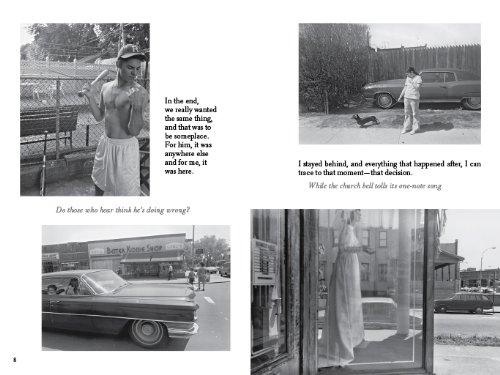
Thomas Roma and Giancarlo Roma, The Waters of Our Time (2014), inside spread
At least for anyone of the narrator’s approximate age, like myself, and perhaps for younger others as well, this roots her story firmly in the 1960s, when Merrick wrote it and Havens made it his own. That’s unfortunate, because while the story may begin there it presumably runs through to the present day. And the pictures — made in Brooklyn over decades by Roma — do not portray any particular era in Brooklyn, nor indeed anything specific to Brooklyn; he could have made almost any given image in the book at any time over the past 60 years, in many parts of this city or even any east coast metropolis. Additionally, the use of this lyric adds another voice — a male one — to the tale, as if the author did not entirely trust his own ability to sustain the flow of his main character’s interior monologue.
The replication of Sweet Flypaper‘s design has consequences for the reader/viewer’s engagement with Roma’s images as well. Most of DeCarava’s pictures qualify as portraits that he made close up to his subjects, so they convey their content effectively even when scaled to this book’s compact dimensions. Because he photographed mainly in interiors, always by available light, and emphasized the dark end of the tonal scale, they are uniformly low-key. DeCarava’s working method required relatively slow shutter speeds, resulting in slightly blurred images — not soft-focus, merely less than razor-sharp due to camera movement and/or motion on the subjects’ parts. Facial expression, gesture, body language come through clearly; environmental detail does not, but in these images that is secondary even when visible. So Sweet Flypaper‘s small size suits DeCarava’s intimate images perfectly.
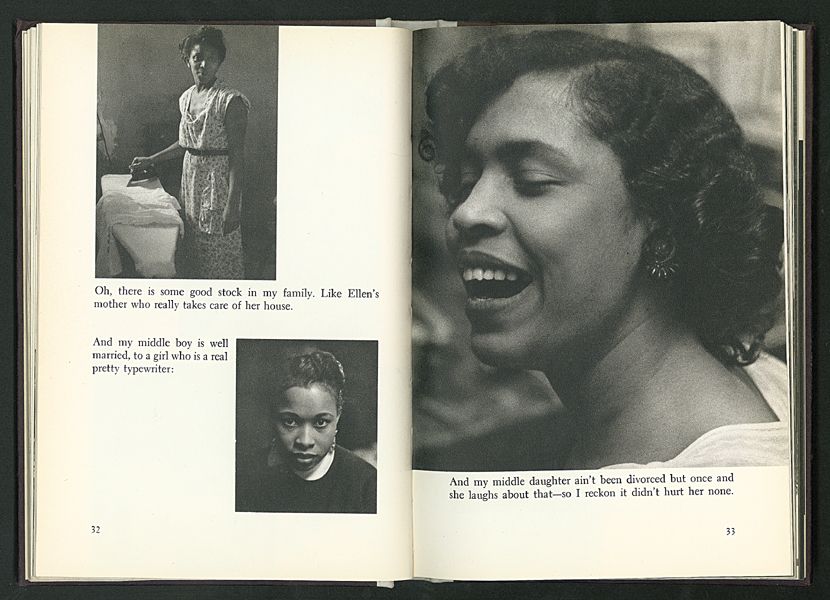
Roy DeCarava and Langston Hughes, The Sweet Flypaper of Life (1955), inside spread
Roma made his high-key pictures — mostly exteriors, frequently sunlit city scenes, many of them urban vistas — in extreme sharp focus. Presented at this scale, effectively miniaturized, much of their presumable content becomes hard to identify. They ask for a larger format so that they can reveal their richness of detail, which gets lost in these small reproductions.
So, in the final analysis, this book’s imitation of the design of Sweet Flypaper strikes me as a lazy and ill-considered decision by the Romas and Marvin Hoshino, who gets credited as designer for this tome. Instead of simply paying their respects to the DeCarava-Hughes project as inspiration and jumping-off point, but with its own independent form and structure, this formal cloning identifies it as a self-conscious hommage.
And more than that; its precise echoing of its source positions it as a wannabe companion piece, an aspiring equal, intended to stand beside Sweet Flypaper and get compared to it. Arrogant, to say the least, and an unwise wager to boot, because it simply doesn’t resonate (for me, in any case) in the way that the DeCarava-Hughes classic did and still does.
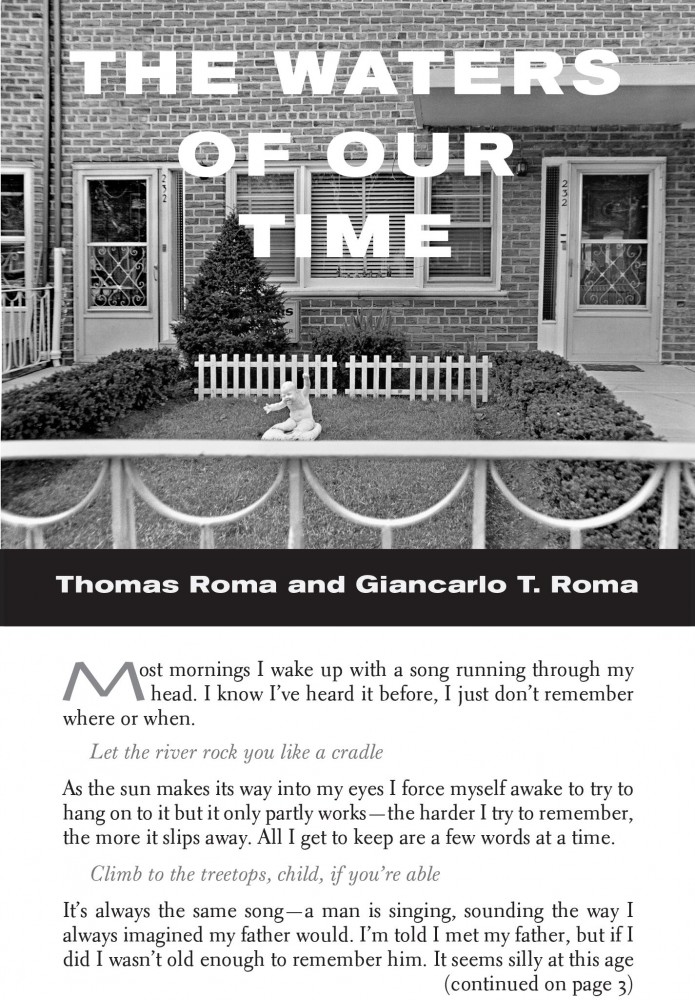
Thomas Roma and Giancarlo Roma, The Waters of Our Time (2014), cover
Yet even if I judge it as failed, I don’t question its presence in this collection. Libraries (other than purely personal and private ones) don’t gather only works considered important, and researchers don’t restrict their investigations to what they or others assess as successful. The Romas certainly put time, effort, and thought into this project; their publisher put considerable money into it. So it has something to tell us, now and in the future, about the photo book in our time, and serves, at the very least, as a strange footnote to the key work that it seeks to emulate — evidence of the enduring influence of the classic after which it has modeled itself.
Libraries exist to offer us the ideas of others, with the implicit challenge of making up our own minds about what they have to tell us. With its inclusion of this book, on that day, the Teti Collection had done its job, and done it well, so far as I was concerned.
On that odd note, placing the books on the carrel for reshelving, I closed my laptop, packed up my things, turned off the lights, let myself out of the Special Collections room, locked the door behind me, hung the keys back on their hook in the library office, said goodbye to librarian Martha Sawyer, and drove back to my lodgings through the changing colors of the autumn trees.
•
This post sponsored by a donation from Carlyle T.
•
Special offer: If you want me to either continue pursuing a particular subject or give you a break and (for one post) write on a topic — my choice — other than the current main story, make a donation of $50 via the PayPal widget below, indicating your preference in a note accompanying your donation. I’ll credit you as that new post’s sponsor, and link to a website of your choosing.
 Include a note with your snail-mail address (or email it to me separately) and I’ll include three (3!) copies of The Silent Strength of Liu Xia, the catalog of the 2012-13 touring exhibition of photos by the dissident Chinese photographer, artist, and poet, who, after eight years of extralegal house arrest in Beijing, finally got released and expatriated to Germany in 2018. The only publication of her photographic work, it includes all 26 images in the exhibition, plus another 14 from the same series, along with essays by Guy Sorman, Andrew Nathan, and Cui Weiping, professor at the Beijing Film Academy. Keep one for yourself, share the others with friends.
Include a note with your snail-mail address (or email it to me separately) and I’ll include three (3!) copies of The Silent Strength of Liu Xia, the catalog of the 2012-13 touring exhibition of photos by the dissident Chinese photographer, artist, and poet, who, after eight years of extralegal house arrest in Beijing, finally got released and expatriated to Germany in 2018. The only publication of her photographic work, it includes all 26 images in the exhibition, plus another 14 from the same series, along with essays by Guy Sorman, Andrew Nathan, and Cui Weiping, professor at the Beijing Film Academy. Keep one for yourself, share the others with friends.






“Libraries exist to offer us the ideas of others, with the implicit challenge of making up our own minds about what they have to tell us.” Thank you Allan, and so true, this being a case study. Your review of the DeCarava/Hughes and Roma books inspired me to “checkout” my own Hennepin County online card catalog (a marvelous feature itself) and discover that they had both books among their extensive photographic holdings. A quick click and they were transported to my nearest branch location, awaiting pickup at my convenience. Just one of the reasons (to my mind) our public library systems are among America’s greatest treasures! Now, having read both books for the first time,I can also agree fully with your well-reasoned analysis of what worked for the former and not the latter. Thanks again Allan, for being “like a library” and opening our minds to the ideas of others!
I enjoy functioning “like a library,” as you put it. I’m in excellent health, but given the short memories of so many — and the ignorance of even recent history that afflicts the young — I think sometimes of this saying: “Un vieillard qui meurt, c’est une bibliothèque qui brûle.” (When an old person dies, a library burns.) Attributed to the Malian cultural historian Amadou Hampâté Bâ, in 1960.